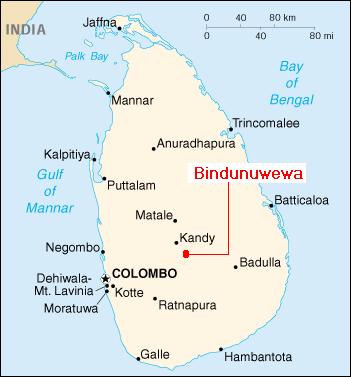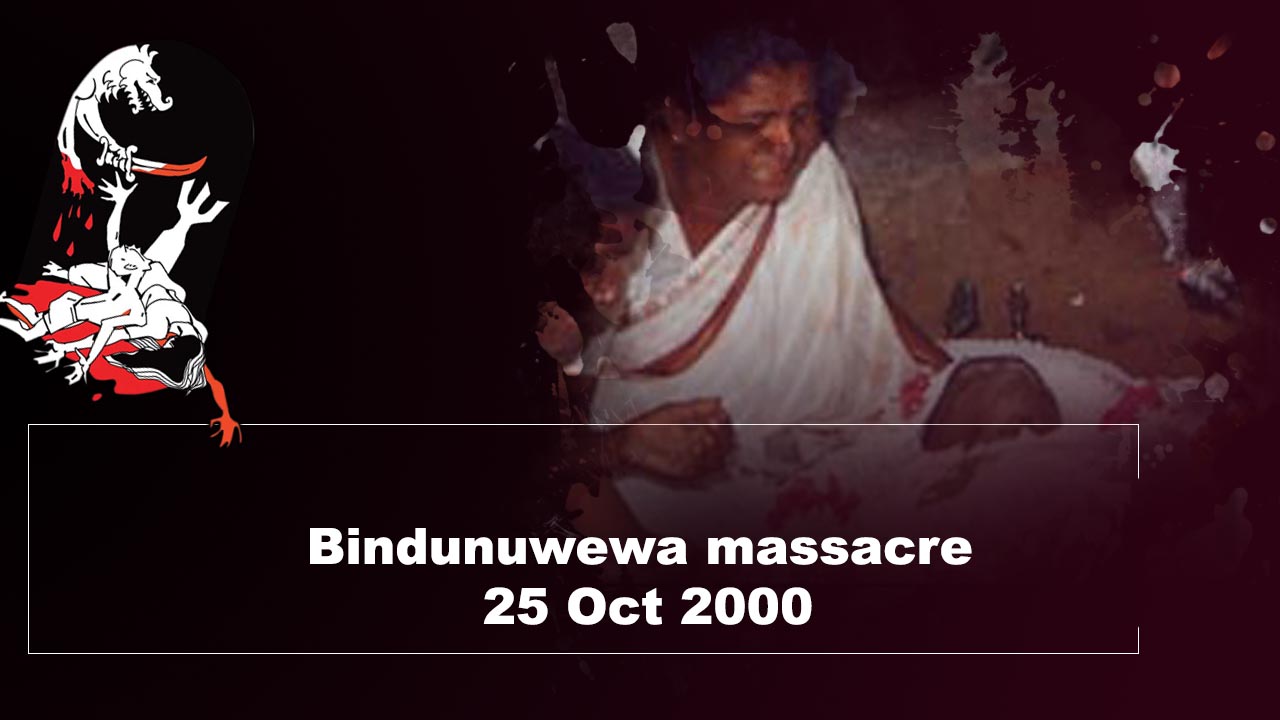Bindunuwewa Rehabilitation Centre was one of three centres run with substantial overseas funding to rehabilitate LTTE suspects and surrenders. The government of Sri Lanka ran these centres. It was shown off as a model for the rehabilitation of former LTTE members thus accumulating a lot of merit points for the government.
On Oct 25th in 2000 a mob of Sinhalese stormed the camp and massacred the inmates while 60 police officers stationed that night to protect the inmates stood by. 28 inmates died and another 14 were seriously injured. There were nine survivors. Two inquiries, one by the Sri Lankan Human rights Commission (SLHRC) and another Presidential Commission of Inquiry (PCI) followed. A criminal proceeding also was initiated. In June 2005 the court proceedings were completed. No one was convicted for any offence.

The massacre as told by the survivors to Sri Lanka Human Rights Commissions (SLHRC)
On October 24, the detainees were raising some complaints they had with the Officer in Charge. Their complaints were that letters to and phone calls for them were not being passed onto them; and they were being detained for more than a year rather than the three-nine month period. There were some arguments and seeing that the detainees were agitated a policeman fired in the air. The situation calmed down and the detainees went to bed.
Next morning when the detainees woke up they saw large crowds and a large number of policemen outside. The crowd started to attack the detainees and set fire to their residences. 28 Tamil detainees died and 14 were injured at the end of the carnage. Nineteen victims were identified and nine victims were not identified because their bodies were burned beyond recognition.
Interim Report by the SLHRC on November 1st 2000
This report by the SLHRC through its name suggests that there will be another report following it but there was no further report from SLHRC on this matter. Major points raised in this report are:
1. When the detainees who were being attacked tried to run for safety one of them was shot down by police officers. His body had three bullet wounds. One of the survivors lost two fingers as a result of the shooting by the police officers.
2. The 60 odd police officers at the scene failed to take any action to stop the carnage. Yet the SLHCR did not lay any criminal responsibility on the police officers rather they were found guilty for the minor offence of dereliction of duty.
3. There was substantial organizing and poster campaign against the inmates between the time the detainees protested and the time they were attacked by the mobs.
Report by the Presidential Commission of Inquiry (PCI)
The report by the Presidential Commission of Inquiry appointed in March 2001 handed its report to the President in early 2002. It was never made public. In any case it was not mandated to inquire and recommend any prosecution. Other papers written on the topic however, have published parts of the findings in this report.
The Commission found clear evidence that a significant degree of organizing took place in the twelve to fourteen hours between the initial protest in the camp and its violent destruction.
The crowd outside initiated the violence as stones were thrown at the inmates. The inmates reacted to the provocations by exploding a gas cylinder within the camp. While this initially succeeded in frightening the crowd, its ultimate effect seems to have been to further inflame things, as the crowd soon thereafter stormed the camp as the police looked on.
That there was an utter failure on the part of the police stationed around the camp is beyond dispute. The Commission report strongly criticized the two most senior police officers in the area – ASP Dayaratne and HQI Seneviratne for a series of failures. Even at the last moment, the inmates could have been evacuated from the camp.
The prosecution

Criminal Investigation Department (CID) carried out its own inquiry and indicted 41 suspects including 10 police officers. There were flaws in the prosecution at many levels. Some of which are:
1. Although both inquiries have strongly criticized that there were substantial prior organizations before the mob stormed the camp there was no attempt to investigate the “organized nature of the massacre”.
2. There was no attempt to lay charges for the criminal conduct of the police in allowing the massacre to continue while they stood by. Nor was the police shooting of the fleeing inmates investigated.
3. There was a systematic destruction of evidence. A bullet from the body of the detainee who was killed by police shooting was removed and was not available as evidence.
4. Though two higher-ranking officers were clearly identified in the inquiries they were never charged of any crime. All the police officers who were charged are middle and low ranking officers.
5. The charges that were brought on the suspects were for murder and attempted murder. The prosecution did not lay any lesser charges for which there would have been a greater possibility of conviction.
Despite such blatant criminality the Sri Lankan justice system has allowed all the culprits to go free. This is also not the only time this has happened. Indeed, this failure of the Sri Lankan justice system to punish security persons for crimes against Tamil civilians has a very long history.
